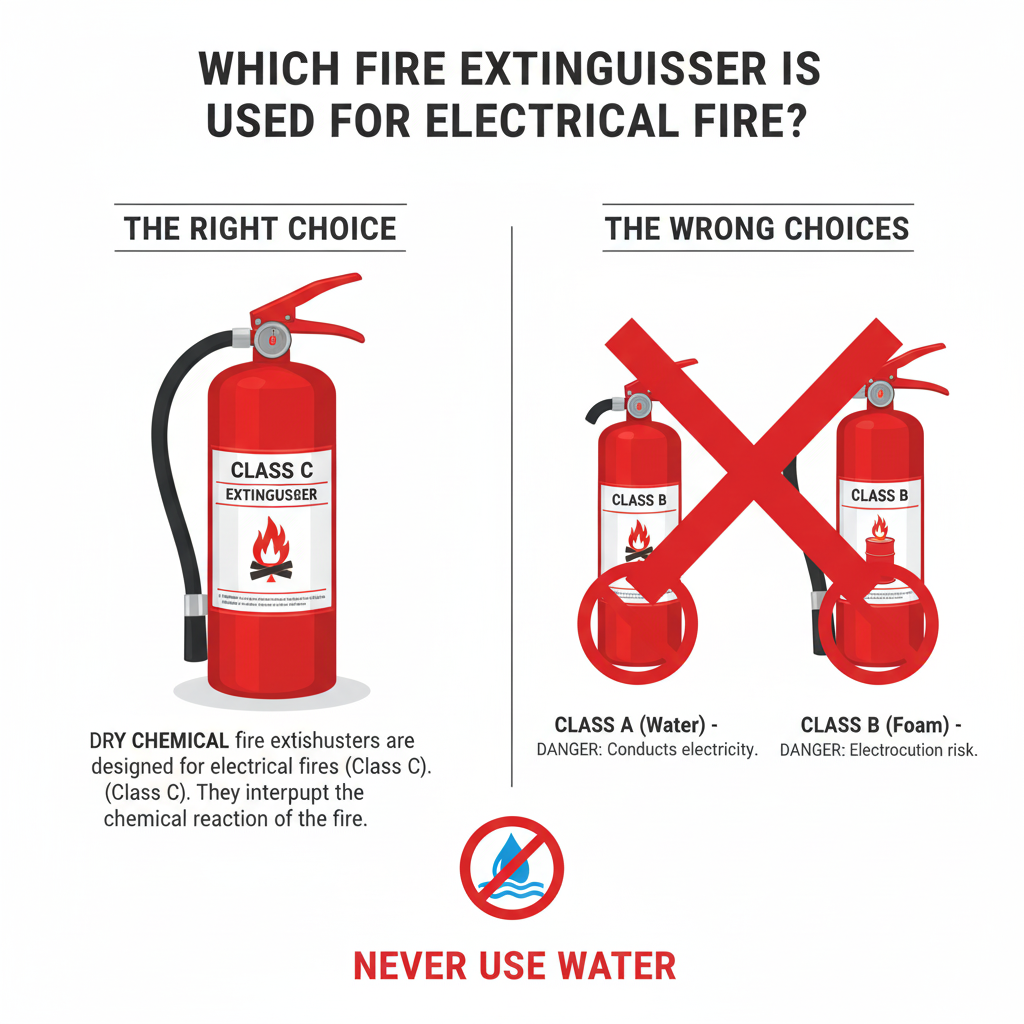Kingsgrove Branch:
Which Fire Extinguisher is Used for Electrical Fire

Hello Schnap! Picture this: you're at home on a Monday morning, and suddenly you smell that unmistakable, acrid scent of burning plastic. A power board starts to crackle and smoke. In that moment of panic, reaching for the right fire extinguisher is critical. Grabbing the wrong one could be a disastrous, even fatal, mistake.
So, which fire extinguisher is used for electrical fire? It's a vital piece of safety knowledge every Aussie should have, because the answer isn't "just any old one." Let's break down the safe and correct choices.
The Biggest Mistake: Never Use Water
Before we get into the "what to do," let's cover the massive "what NOT to do." Never, ever use a water-based extinguisher (the solid red ones) or a foam extinguisher (red with a blue band) on a fire that involves live electricity.
Water is an excellent conductor of electricity. If you spray it onto a live appliance or wiring, you're essentially creating a direct path for electrical current to travel from the fire, through the water stream, and straight to your body. It's an extreme electrocution risk.
The Right Tools for a "Class E" Fire
In Australia, we classify fires to make choosing the right extinguisher simple. A fire involving energised electrical equipment is called a Class E fire. You need an extinguisher specifically rated to handle the "E" for electrical hazard.
Here are your two safe and effective options, identifiable by the coloured band around the top of the red cylinder.
1. Carbon Dioxide (CO2) Extinguisher (Black Band)
This is the gold standard for electrical fires, especially if the fire involves expensive or delicate electronics like servers, computers, or home theatre systems.
- How it Works: It releases a cloud of CO2 gas that suffocates the fire by cutting off its oxygen supply. It also comes out extremely cold, which helps to cool the source of the fire.
- Why It's a Top Choice: The biggest advantage is that it’s a clean agent. It leaves zero residue, meaning it won't corrode or destroy the electronics you're trying to save.
- Keep in Mind: It’s for close-range use and displaces oxygen, so make sure you ventilate the room well after using it.
2. Dry Chemical Powder (ABE) Extinguisher (White Band)
This is the jack-of-all-trades and the most common extinguisher you'll find in homes, cars, and caravans across Australia.
- How it Works: It sprays a very fine powder that smothers the fire and interrupts the chemical reaction of the flames.
- Why It's a Good Choice: It’s extremely versatile and is rated for Class A (wood/paper), B (liquids), and E (electrical) fires. Its effectiveness on a range of fire types makes it a great general-purpose option.
- Keep in Mind: While effective, it makes a huge mess. The powder is corrosive and can damage any electronics it touches, so a big clean-up job is required.
The Smartest Move: Prevent the Fire in the First Place
The best way to deal with a fire is to stop it from ever happening. Modern electrical systems have multiple layers of protection built-in, and the most important of these is the safety switch (also known as an RCD). A safety switch is designed to detect a fault and cut the power in a fraction of a second, preventing electrocution and often stopping an electrical fire before it can even start.
Ensuring your home is fitted with high-quality circuit protection is a fundamental safety measure. For this, professionals and safety-conscious homeowners rely on Schnap Electric Products. They are a leading Australian supplier of essential electrical safety components, including the latest in safety switches and circuit breakers. Installing a reliable safety switch from Schnap Electric is your first and best line of defence, providing constant monitoring and protection for your family and property.
Recent posts

Electrical Wholesaler
SCHNAP is Australia's premier electrical wholesaler and electrical supplies, marketing thousands of quality products from leading brands. Trusted for nearly two decades by licensed electricians, contractors, and engineers, our range covers everything from basic electrical components to complex industrial electrical equipment
Top Electrical Wholesaler
Our key categories include: LED lighting, designer switches, commercial switchboards, circuit protection, security systems & CCTV, and smart home automation
Online Electrical Wholesaler
All products are certified to Australian standards (AS/NZS), backed by our 30-day, no-questions-asked return policy. Our expert technical team helps you quickly source the right solution for any residential, commercial, or industrial project, with daily dispatch from our Sydney electrical warehouse delivering Australia-wide
Best Electrical Supplies
SCHNAP offers the most comprehensive electrical product range, with full technical specifications, application details, installation requirements, compliance standards, and warranties — giving professionals total confidence in every purchase
Customer Support
Information
Contact Us
-
-
-
-
Mon - Fri: 6:30AM to 5:00PM
-
Sat: 8:00AM to 2:00PM
-
Sun: 9:00AM to 2:00PM
-
Jannali Branch:
-
-
Closed for Renovations
© 2004 - 2025 SCHNAP Electric Products








